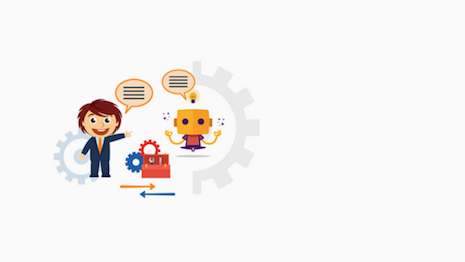 Serious talk on chatbots. Image credit: Gupshup
Serious talk on chatbots. Image credit: Gupshup
By Beerud Sheth
We are in the midst of a once-in-a-decade paradigm shift.
Messaging is the new platform, while bots are the new applications. It radically changes end-user experiences and developer frameworks, and inevitably will change business models, how we monetize, and how we advertise.
While these are still early days, a few interesting trends are becoming apparent. Here are some observations and recommendations for brands entering the brave bot world:
Pull, not push
Messaging is much more of a private space than Web sites or apps ever were. There is less room for intrusive advertising than any other media.
Messaging platforms are also very sensitive about spam.
Messages or bots that lead to user annoyance will get auto-filtered out.
On some messaging platforms, bots will not be allowed to initiate user conversations – only a user will. Therefore, brands must create a pull effect so that users initiate conversations.
Conversational, not visual
Another big change is that the conversational interface is text heavy.
While messages in the future will support rich interactive formats, currently they are mostly text.
So brands will have to discover, and execute on, ways to engage users in a meaningful conversation, rather than just make them view banners or video spots.
Frequent and intense
Messaging apps are a terrific medium for engagement – they are instant, and users tend to be more responsive with it than on other media.
Also, users tend to use messaging apps dozens of times each day.
The brands that enact a smart plan will see much higher frequency and intensity of engagement than with other apps.
Highly personal
Each message is sent to one unique individual; each customer interaction can be customized to that person.
Now brands will acquire the ability to tailor the service to each customer. This will require you to capture context, build user profiles and maintain history.
The user should be able to order pizza, or just about anything else, by saying “usual” soon after the user has some history with the brand.
Given the above, what are some of the use cases that brand bots can enable?
Product search
Brand bots can help users find the right product from the portfolio.
For instance, Sephora recently launched a bot that helps users find the right cosmetic product from its extensive list of SKUs.
Your bot, like Sephora’s, needs to be able to query user requirements and suggest the best matching product for that user – plus provide the option to get detailed product information.
This bot is like the neighborhood bookseller, a friendly advisor, on whose advice customers rely to buy the perfect book.
For brands, this can be a great opportunity to upsell and cross-sell products, within reason.
Customer support
Brand bots ought to have an ability to handle customer complaints and issues from existing customers.
A bot that sells, but does not support, will disappoint customers quickly.
A bot that says “Sorry, not my department” will make a poor impression.
Bots enable brands to reduce or eliminate phone hold time for customers.
Get personal
Brand bots should provide personalized responses in all interactions, whether it be product recommendations, support or offers.
Brand bots must maintain user context and history, as well as build inferences.
While customer support agents, Web sites and apps could get away with being somewhat impersonal, bots today need to be intensely personal.
The reason is that bot conversations happen in the context of a messaging app where every other conversation, be it with family or friends, is just that – personal. Users will be unforgiving of impersonal bots.
Content, not advertising
The adage that advertising is content by other means is even more relevant in the bot world.
Brand bots should share content relevant to the brand category and interesting to the user.
Become a bigger part of the user’s life and you build a stronger brand relationship.
Get discovered
Bot stores are emerging to help users discover new offerings. These are both platform-specific as well as cross-platform bot stores. Brand bots should be listed in both formats.
Additionally, a new advertising model will inevitably emerge where popular bots will, for a fee, refer a user to other bots.
Bot is the brand
Very soon, your bot will become the primary interface for your brand.
Users will visit a bot more than they will visit your Web site, app or offline store. This will be true before, during and after the sale.
Your users will interact with your bot more than they will notice your ads.
In fact, the way to interact with your product may itself be through the bot – for example, message or talk to the bot to switch on the music or play a specific song.
In this cool new era, the bot becomes the product, the bot becomes the brand.
BOTS ARE A major disruption that will create new opportunities and threats for brands.
The opportunity is massive due to the immense reach of messaging platforms, ease-of-use of messaging, frequency of use, and intensity of user engagement.
The risks are great, too.
Brands slow to jump onto the new medium will get disrupted.
The risk of doing nothing is far greater than the risk of doing something.
 Beerud Sheth is founder/CEO of Gupshup
Beerud Sheth is founder/CEO of Gupshup
Beerud Sheth is founder/CEO of Gupshup, a San Francisco-based bot-builder platform. Reach him at beerud@gupshup.io.
